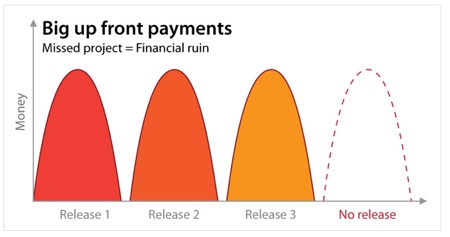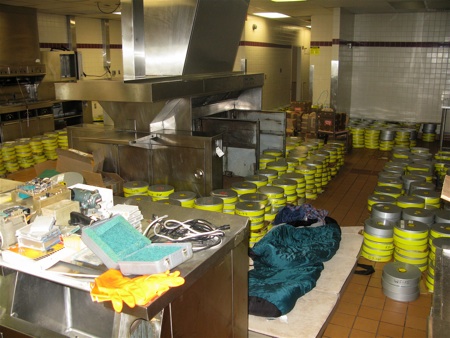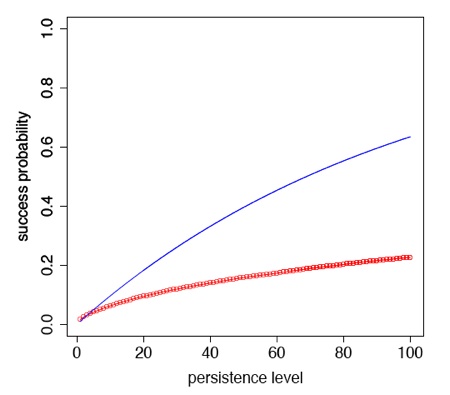Proverbs for the Future
Anne Herbert was a gifted writer who edited CoEvolution Quarterly (the periodic magazine of the Whole Earth Catalog) before I did in the early 1980s. We never worked together, or were close friends, but I really dug her writing. It was telegraphic, lyrical, abbreviated, evocative, extremely personal and mystical. She wrote in short bursts. Like proverbs from a secret bible. Brian Eno noticed her stuff works really well on t-shirts. It was not like any writing I had encountered. (She came up with the phrase “practice random kindness and senseless acts of beauty” which later became a meme.) Readers loved her; but publishers did not get her.
After one book of her work that sank on the marketplace, she disappeared in the mid 1980s and never published again even in magazines. I often wondered about her. She was decades ahead of her time. I always thought her stuff was perfect for blogs and twitter. But after 1990 no one I knew had seen her.
Recently I discovered that she is still going, still writing and that she has a weekly blog! In fact she has been blogging since 2005! I’ve been reading her online recently although she doesn’t know it. She’s as good as ever. She is the epitome blog/twitter writer IMHO. It turned out she had been broadcasting 140 character tweets and bursty blog postings long before either media existed.
I love her sensibility. You might too.
Some recent samples. These are not cut or edited. These are the entire entry.
Do less; have less; be more.
***
Flawedness is the only option. I disagree, but there it is. I don’t know how to deal with flawedness in myself or others. Now, that’s a flaw.
***
Music fans are more likely than musicians to love the kind of music they love and disdain other kinds.
Musicians are more likely to love music as a group and to be riveted by at least one kind of music their fans feel is wrong, so very wrong.
***
Renata Adler was a New York Times movie critic who brought to the job the gift of not being particularly fond of movies as an art form. She almost didn’t like them as a group.
This gave her access to general insights less available to lovers of the form.
She said you can’t make an anti-war movie because film always says yes to what it shows.
****
Sometimes the people who invent things and the people who find out what things are for are different people.
***
Someone who has been deeply wounded must be deeply healed.
***
I twist myself into a pretzel to believe the story, the official story of some group I like, to stay inside a “we” I want. Not much nutritional value.
***
I might have to cry for a hundred thousand years. Or maybe an accurate laugh would do some of the same work.
***
While I’m thinking about this problem, what is the part I am skittering away from?
***
All that room inside a minute, all those seconds, hundredths of a second. All those nanoseconds, and here comes another minute, moving and spacious.
Effective Apology Skills
One of the essential skills in life is learning how to apologize with grace and honesty. For real. A genuine apology can move mountains.
We expect character from corporations even though they are not people, but when business do behave like upstanding people, we notice. Amazon did a silly thing recently by disabling books that they mistakenly sold on the Kindle. Founder Jeff Bezos just posted an apology that raised him two notches on my Buddha scale. It takes courage and wisdom to apologize as genuine and effectively as his did. Man, he is good.
This is an apology for the way we previously handled illegally sold copies of 1984 and other novels on Kindle. Our “solution” to the problem was stupid, thoughtless, and painfully out of line with our principles. It is wholly self-inflicted, and we deserve the criticism we’ve received. We will use the scar tissue from this painful mistake to help make better decisions going forward, ones that match our mission.
With deep apology to our customers,
Jeff Bezos

The Long Book
Good things can be done over long times. Oxford University, with its multi-century history and perspective, is one of the few institutions to support very long-term projects. Oxford University Press will this year release a book that has taken almost 45 years to finish. It’s the world’s largest thesaurus — and includes almost the entire vocabulary of English. The project was begun in 1965. (Thanks, Joe Stirt)

According to the BBC report:
The work was nearly destroyed in a fire in 1978, but despite the building being gutted, a metal filing cabinet protected the files. A spokesman said the final tome would contain over 230,000 categories with 800,000 meanings. The thesaurus was nearly completed in 1980, but the team decided to include words from updated versions of the Oxford English Dictionary. This added almost 30 years more work to the project.
One wonders what other kinds of things could we do if we were willing to devote half a century to it?
According to Oxford U Press the book features:
- A unique thesaurus resource – the very first historical thesaurus to be compiled for any of the world’s languages
- The largest thesaurus resource in the world, covering more than 920,000 words and meanings from Old English to the present day based on the Oxford English Dictionary
- Synonyms listed with dates of first recorded use in English, in chronological order, with earliest synonyms first
- Uses a thematic system of classification, with synonyms and related words forming part of a detailed semantic hierarchy
- Comprehensive index enables complete cross-referencing of nearly one million words and meanings
- Contains a comprehensive sense inventory of Old English
- Includes a free fold-out colour chart which shows the top levels of the classification structure
You can preorder the “Historical Thesaurus of the Oxford English Dictionary: With Additional Material from A Thesaurus of Old English” at Amazon for $316.

Five Unstoppables
An unstoppable is a trend or entity with so much forward momentum, centrality, and success that it seems unstoppable. I don’t mean “too big to fail” I mean too unstoppable to stop.
Yet, eventually every unstoppable slows down, even if they don’t vanish, and they usually don’t. (Unlike the “too big to fails.”) How are unstoppables stopped? I recall how hard it was to imagine how unstoppable Japan would be stopped in the 1990s? Real estate was not mentioned. It is always hard to imagine how any great power declines while it is at its peak. But all will.
I see five “unstoppables” reigning in popular imagination now.
Google, China, the Singularity, Moore’s Law, and the US.
Recently a few contrarians have taken a stab at how the US might fall apart, as mentioned previously. Here’s a recent not very convincing argument against Moore’s Law continuing much beyond 2014. Vernor Vinge himself fashioned four arguments against his singularity thesis (that is greatness!). There’s a few arguments against China. This one in Foreign Policy has some good points, but I find myself not persuaded for some reason. Excerpts:

For complex reasons, China’s rise has inspired fear and unease, not enthusiasm, among Asians. Only 10 percent of Japanese, 21 percent of South Koreans, and 27 percent of Indonesians surveyed by the Chicago Council on Global Affairs said they would be comfortable with China being the future leader of Asia.
*
Another, perhaps more important, reason for the enduring American preeminence in Asia is that most countries in the region welcome Washington as the guarantor of Asia’s peace. Asian elites from New Delhi to Tokyo continue to count on Uncle Sam to keep a watchful eye on Beijing.*
China appears to have done much better in these areas. But appearances can be deceiving. Dictatorships are good at concealing the problems they create while democracy is good at advertising its defects.
I’d love to see a good set of believable scenarios on how Google eventually gets sidelined.
How to Get People to Pay
Figuring how to make money in freeconomics is the challenge of our times. While the free is always an option (that is the point of Technology Wants to Be Free and Chris Anderson’s new book “Free: The Future of a Radical Price”), free is NOT the only option. Sometimes the best way make money is to actually charge fans for what you produce. Dan Cook who is flash game developer has written an amazingly comprehensive and level-headed outline of the options available for creators. I think his guidelines work not just for gamers but for photographers, musicians, software programmers, authors and anyone else producing in the digital economy. It is brilliant, honest, wise.
I think this tutorial the best thing on the digital economics since Better Than Free.

Dan says:
When you design your game, pick three or four revenue streams and build them into your game. Here are some categories of users that you may want keep covered.
- People who don’t want to pay: Advertising is a good option to keep around. A few hundred bucks is still money in the bank.
- People who are interested in more of the same: Once you’ve established the value of your game, some players want more. Give them more levels, more puzzles, more enemies in exchange for cash.
- People who are interested in status or identity improvements: Some people see games as means of expression and identity. Give them items that let them express themselves or customize their experience.
- People who have limited time: Some people live busy lives and want to consume your game when they desire and how they desire. Cheat codes, experience multipliers and other systems that bypass the typical progression all help satisfying this customer need.
Innovative Publishing Model

I like this experimental book publishing model. Print 200 copies of a book in hard cover. Sell with “free” shipping. Then make the rest of the copies free as a downloadable PDF. I missed getting one of the limited edition 200 ($9, postage paid), since they sold out in 8 hours. It really doesn’t matter what’s in the book. The model is brilliant, if you have an audience. The scarce limited edition of the physical subsidizes the distribution of the unlimited free intangible.
Here is what their website says:
We’ll post a PDF online, free for everyone—but only after we sell this run of 200 real, physical objects. So think of it this way: You’re not just buying a thought-provoking, take-it-to-the-coffee-shop book for yourself. You’re buying access for everybody. You’re a patron of the new liberal arts!
As it happens, the PDF reveals that the content is pretty thin. But it did not have to be. Their premise is great (the new literacies), and their biz model innovative. We can hope they try again. I am impressed enough with the experiment to use this model on my next self-published book.
Investigative journalism by amateurs
Will bloggers ever go to the same lengths that professional journalists do to get a good story? I mean, without a payroll? Newspapers claim it will never happen.
Sometimes it will. The following is a wonderful case where very passionate fans did their own amazing science and investigative research worthy of any national newspaper or world-class magazine. The story is about whether vegan resturants in LA are truly vegan, but the larger story is how deep and thorough their investigation was. I’d be curious to know where they learned their skills.
Oh, if you are a vegan (or even a vegatarian) you’ll want to read this.

UPDATE: Avi Solomon suggested another in-depth investigative report generated outside of professional journalists. Three students from Singapore created this very impressive long-form article, with photos, of Surrogate Motherhood in India, “the ultimate outsourcing job.”
Vanishing Muslims and the Shift to Africa
There’s much news in this startling piece on unexpected global demographic trends in The Wilson Quarterly. It suggests that a possible discontinuity in world affairs may soon arrive in the demographics of Africa. The short story:
The canonical Muslim countries of today, and the Muslim populations in Europe, are rapidly losing fertility. There will be less Muslims in these classical centers of Islam. At the same because of immigration from Eastern Europe, Old Europe is rebounding with raised fertility rates.
But Africa is going monotheist. It will become both the center of Islam’s population and Christianity’s.
This rich piece has such details as:
Iran is experiencing what may be one of the most dramatic demographic shifts in human history. Thirty years ago, after the shah had been driven into exile and the Islamic Republic was being established, the fertility rate was 6.5. By the turn of the century, it had dropped to 2.2. Today, at 1.7, it has collapsed to European levels.
One striking implication of this growth is that there will be a great religious revolution, as Africa becomes the home of monotheism. By midcentury, sub-Saharan Africa is likely to be the demographic center of Islam, home to as many Muslims as Asia and to far more than inhabit the Middle East. Christianity will also feel the effects of Africa’s growth. By 2025, there will be as many Christians in sub- Saharan Africa— some 640 million— as in South America. By 2050, it is almost certain that most of the world’s Christians will live in Africa. As Kenyan scholar John Mbiti writes, “The centers of the church’s universality [are] no longer in Geneva, Rome, Athens, Paris, London, New York, but Kinshasa, Buenos Aires, Addis Ababa, and Manila.”

Catholic church in Dogon, Mali, by Mark Moxon.
The article also knocks down the conventional wisdom that Chinese will remain the most populous group in the near future.
At the turn of this century, the conventional wisdom among demographers was that the population of Europe was in precipitous decline, the Islamic world was in the grip of a population explosion, and Africa’s population faced devastation by HIV/AIDS. Only a handful of scholars questioned the idea that the Chinese would outnumber all other groups for decades or even centuries to come. In fact, however, the latest UN projections suggest that China’s population, now 1.3 billion, will increase slowly through 2030 but may then be reduced to half that number by the end of the century.
Digital Recovery of Moon Images
It is very difficult to keep digital data moving forward in time. I call that movage and its hard to do. Exhibit A: “Mankind’s first up-close photos of the lunar landscape have been rescued from four decades of dusty storage.”
Steve Jurvetson writes:
Behind the counter of an abandoned McDonalds lie 48,000 lbs of 70mm tape the only copy of extremely high-resolution images of the moon.
Forty years ago, unmanned lunar orbiters circled the moon taking extremely high-res photos of the surface to plan landing spots for Apollo 11 onward… In this McDonalds, the only copy of that data is about to be resurrected. These tapes were recorded 40 years ago as part of the Apollo program to map the lunar surface to plan landing spots for Apollo 11 onward. They have never been seen by the public because at the time, they were classified as they reveal the extreme precision of our spy satellites. Instead, all we have ever seen are the grainy photo-of-a-photo images that were released to the public.
The spacecraft did not ship this film back to Earth. Instead, they developed the film on the Lunar Orbiter and then raster scanned the negatives with a 5 micron spot (200 lines/millimeter resolution) and beamed the data back to Earth using yet-to-be-patented-by-others lossless analog compression. Three ground stations on Earth (one was in Madrid) recorded the transmissions on these magnetic tapes.
Recovering the data has proven to be very difficult, requiring technological archeology. The only working version of the Ampex tape player ($300K when new) was discovered in a chicken coop and restored with the help of the original designer. There is only one person on Earth who still refurbishes these tape heads, and he is retiring this year. The skills to read this data archive are on the cusp of disappearing forever.
Some of the applications of this project, beyond accessing the best images of the moon ever taken, are to look for new landing sites for the new Google Lunar X-Prize robo-landers, and to compare the new craters on the moon today to 40 years ago, a measure of micrometeorite flux and risk to future lunar operations.

From KTVU:
In an abandoned McDonald’s restaurant on NASA Ames property in Mountain View, a pirate flag is taped to the window. Inside, it gets even stranger. Three researchers huddle around a wheezing 45-year-old Ampex FR-900A tape machine, a one-of-a-kind reel to reel 2-inch model designed to record data for the National Security Agency. It now sits where people used to wolf down Big Macs. Behind the counter, where the fry-tubs and refrigerators used to be, one-thousand five hundred 14-inch diameter tape reels are clustered in five piles. Each reel has a two letter identifier followed by three numbers. “These tapes hold the best images of the moon ever taken, even to today,” says Dennis Wingo, a lanky 55-year-old engineering physicist who heads the Lunar Orbiter Image Recovery Project.
From Moonviews:
Those images include a high-resolution version of “Earthrise,” the first picture of the Earth from the Moon’s vantage point. Time Magazine has called this image “the photo of the century.” The tapes also contain the first stereo imagery of the Moon’s surface. Indeed, these are some of the best images of the Moon ever taken, far superior from those received from the Hubble telescope.
Astonishingly, all of the images stored on the 1,500 14-inch diameter tape reels were nearly destroyed. With its focus turned to the Apollo mission, NASA saw little further use for the tapes. Fortunately, Nancy Evans, co-founder of NASA Planetary Data Systems, convinced her superiors at the Jet Propulsion Laboratory to retain the tapes. Evans also salvaged three refrigerator-sized FR-900 tape drives, which she stored in her own garage for two decades. Evans and Mark Nelson, of Caltech, managed to get a few tape drives running but their project ultimately folded. NASA turned down her requests for assistance after placing an estimate of $6 million on the cost to restore the data.
More details of this unlikely rescue operation from Dr. X
This project started in the late 1980’s when the National Space Science Data Center (NSSDC) discovered a cache of the only known remaining set of Lunar Orbiter tapes in existence stored in a “salt mine.” The story there is that there are abandon salt mines that store government records, as the temperature and humidity are stable. There was some documentation attached indicating what they were and that JPL should be notified as to what their ultimate fate should be. JPL took possession of them in about 1988 or so, as there was some interest in recovering the data so that the images could be digitized and made available to the general public as the pictures were then a bulky 2000, 28″ x 30″ prints. The problem at that point was that no one knew what technology created the tapes so the format and method was unknown. At the time a private consulting firm became aware of the project and decided to research the issue with the purpose of proposing a data recovery project. After amassing all the Lunar Orbiter literature available, it was determined that the Ampex FR900 tape recorder (the first real video tape recorder), was used to create the tapes. More importantly it was revealed that the data was in an analog format with the video in a format called “Vestigial Sideband Filtered”, slow scan TV. This knowledge set about the search for any source of FR900 tape drives. The search covered NASA sites, Vandenberg’s Pacific Missile Range at Kwajalein, the CIA and Egland AFB’s radar test site in Florida. Ultimately a total of four tape drives were obtained and as far as is known, are the only remaining drives of their type in the world.
The Persistence Paradox
Listen to this summary of a new paper (PDF) by the reknowned internet researcher Bernardo Huberman (now at HP Labs):
People persistently upload content to social media sites, hoping for the highly unlikely outcome of topping the charts and reaching a wide audience. And yet, an analysis of the production histories and success dynamics of 10 million videos from YouTube revealed that the more frequently an individual uploads content the less likely it is that it will reach a success threshold. This paradoxical result is further compounded by the fact that the average quality of submissions does increase with the number of uploads, with the likelihood of success less than that of playing a lottery.
Whoa! So even though their later videos are ranked higher in quality, additional videos posted by users will usually fare worse in popularity than their earlier ones. One caveat: Success in this experiment is measured as the top 1% videos, so in fact the number of views might increase, but the ranking of the video in the overall world of YouTube decreases; it is less of a “hit.”
The researchers say they have no explanation for why folks continue to persist in posting videos despite their lowering hit rankings, but they note, they would have better luck on a lottery. Hit-ness must not be as important as many folks think. I am more impressed that this paper shows that persistence increases quality — which is what any artist will tell you.
So the Persistence Paradox says that persistence increases quality but not hits.

Worse than the lottery. The red line plots the success probability of YouTube producers as a function of their persistence level. The blue line plots the success probability of a producer who participates in a lottery with 0.01 winning probability for each draw, as a function of her persistence level.

